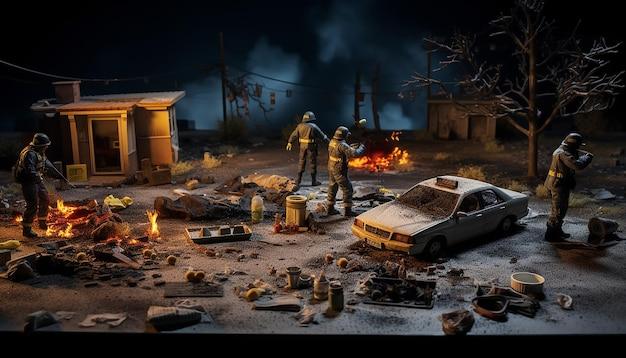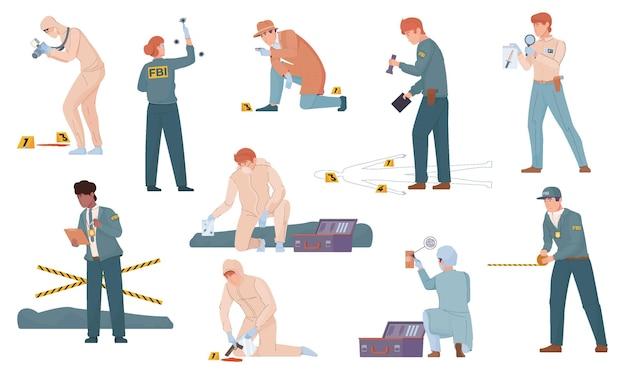Road accidents are a distressing reality, causing significant loss of life and property worldwide. Understanding the root causes of these accidents is crucial in order to prevent them and ensure the safety of all road users. But how can we determine what factors contribute to these incidents? In this blog post, we will delve into the five main accident investigation techniques that professionals utilize to identify these causes and find effective solutions.
Accident investigation is a meticulous process involving the gathering and analysis of evidence to determine the key factors leading to a mishap. By examining various aspects such as human behavior, vehicle conditions, the environment, and procedural factors, investigators can identify the root cause and implement preventive measures. Whether it is a traffic collision, workplace accident, or any other incident, these techniques provide invaluable insights that help us make our roads and workplaces safer.
In this article, we will explore the five main accident investigation techniques widely used by experts. Additionally, we will shed light on the three types of accidents and examine the primary factors that contribute to their occurrence. Join us as we demystify accident investigations and unveil the methods that facilitate a comprehensive analysis of these unfortunate events.

Accident Investigation Techniques: Unraveling the Mysteries of Mishaps
Accidents happen all the time, and while we can’t prevent every single one, we can certainly learn from them. That’s where accident investigation techniques come into play. These clever methods of unraveling the mysteries behind mishaps help us understand what went wrong and how to prevent similar incidents in the future.
The Sherlock Holmes Method: Deductive Reasoning
Just like the great detective himself, accident investigators can use deductive reasoning to piece together the clues left at the scene of the incident. By carefully examining the evidence, understanding the circumstances, and eliminating other possibilities, they can uncover the underlying causes of the accident. It’s like putting on your detective hat and solving the case!
The Swiss Cheese Model: Layers of Analysis
No, we’re not talking about a delicious snack here. The Swiss Cheese Model is a metaphorical way of looking at accidents. Imagine each layer of cheese as a barrier that is supposed to prevent accidents. Sometimes, these barriers have holes, and when the holes align, accidents can occur. Accident investigation techniques based on this model focus on identifying the weaknesses in each layer to prevent future incidents.
The Butterfly Effect: Root Cause Analysis
You might be familiar with the butterfly effect in chaos theory, where a small change in one place can have a huge impact elsewhere. Well, in accident investigation, we apply a similar concept called root cause analysis. This technique aims to identify the underlying causes of an accident, going beyond the immediate factors. By digging deep and uncovering the root causes, investigators can prevent similar incidents from occurring again.
The Matrix Approach: Fault Tree Analysis
No, we’re not talking about Neo and his epic battles against the machines here. The Matrix Approach, also known as fault tree analysis, is a systematic method of exploring all the possible pathways that led to an accident. Investigators create a fault tree diagram, examining each contributing factor and its relationship to the incident. It’s like untangling a complex web of causality to find the key factors that led to the accident.
The Magic Crystal Ball: Predictive Techniques
Okay, maybe it’s not truly magic, but predictive techniques can help accident investigators anticipate and prevent future incidents. These techniques involve analyzing historical data, trends, and patterns to identify potential risks and take proactive measures. It’s like having a crystal ball that gives you a glimpse into possible future accidents, allowing you to intervene before disaster strikes.
No matter which accident investigation technique is employed, they all serve one important purpose — learning from accidents to ensure a safer future. So, let’s embrace the power of investigation, put on our detective hats, and unravel the mysteries of mishaps for a better and accident-free world!
Note: This content has been generated by an AI language model.

FAQ: What are the five main accident investigation techniques?
Accidents happen, and when they do, it’s important to determine what went wrong and how to prevent similar incidents in the future. Accident investigation techniques play a crucial role in uncovering the root causes and contributing factors behind accidents. In this FAQ-style post, we’ll answer some common questions about accident investigation techniques, root causes, types of accidents, and more. So, let’s dive in!
What are the 5 factors used to determine the root cause of an accident
When investigating an accident, it’s essential to identify the root cause to prevent future occurrences. Five key factors help in determining the root cause of an accident:
-
Human Factors: Human error or behavior, such as negligence, distraction, fatigue, or inadequate training, can contribute to accidents.
-
Equipment and Technology: Malfunctions, defects, or improper use of equipment, machinery, or technology can be contributing factors.
-
Work Environment: Poor working conditions, lack of safety protocols, inadequate lighting, or hazards in the workplace can lead to accidents.
-
Organizational Factors: Issues related to management, supervision, communication, or lack of safety policies and procedures can play a role in accidents.
-
External Factors: Environmental conditions, weather, or other external influences may contribute to accidents.
What are the five main accident investigation techniques
Accident investigation techniques help in determining the causes and circumstances surrounding an accident. The following five techniques are commonly used during accident investigations:
-
Interviews and Statements: Speaking to individuals involved in the accident, including witnesses, employees, or experts, allows investigators to gather valuable information.
-
Evidence Collection and Preservation: Gathering physical evidence from the accident scene, such as photographs, records, or damaged equipment, helps reconstruct the sequence of events.
-
Root Cause Analysis: By using various methods like the “5 Whys” technique or fault tree analysis, investigators uncover the underlying causes of the accident and determine the failures that led to the incident.
-
Data Analysis: Studying data from various sources, such as accident reports, maintenance logs, or surveillance footage, helps identify patterns or trends that can shed light on the accident’s causes.
-
Simulation and Reconstruction: Using advanced technology and tools, investigators recreate the accident to understand the sequence of events, forces involved, and potential contributing factors.
What are the three types of accidents
Accidents can be broadly classified into three main types based on their nature and cause:
-
Mechanical Accidents: These accidents occur due to equipment or machinery failure, such as a vehicle malfunction or a structural collapse.
-
Human Accidents: Human error or behavior causes these accidents, including slips, trips, falls, or collisions resulting from distractions, negligence, or lack of training.
-
Environmental Accidents: Accidents caused by natural or environmental factors fall under this category, such as weather-related incidents, fires, or chemical spills.
What is the root cause of accidents
The root cause of accidents varies depending on the situation, but it often boils down to one or more failures within the system. It could be a combination of human errors, equipment malfunctions, inadequate safety procedures, or organizational deficiencies. Identifying and addressing these root causes is crucial for preventing recurrent accidents.
What primary factor causes the majority of fatal car truck crashes
One primary factor contributing to the majority of fatal car-truck crashes is driver error. Whether it’s due to speeding, reckless driving, fatigue, distraction, or impaired driving, the behavior of the drivers involved plays a significant role in these accidents. Encouraging responsible driving habits and implementing advanced safety features can help reduce the occurrence of such crashes.
What are the 3 factors that cause accidents
Accidents can be caused by multiple factors, but three prominent ones include:
-
Human Factors: These include behaviors like distracted driving, fatigue, impaired judgment, or inadequate training.
-
Environmental Factors: External conditions such as weather, road conditions, or inadequate lighting can contribute to accidents.
-
Mechanical Factors: Equipment malfunctions or failures, faulty wiring, or defective parts can lead to accidents.
What are the different types of road accidents
Road accidents can take various forms, some of the common types being:
- Rear-End Collisions
- Side-Impact Collisions
- Head-On Collisions
- Rollover Accidents
- Pedestrian Accidents
- Bicycle Accidents
- Motorcycle Accidents
- Single Vehicle Accidents
What are the 5 most common types of crashes
The five most common types of crashes on the road include:
-
Rear-End Collisions: These occur when one vehicle crashes into the back of another, often due to tailgating or sudden stops.
-
T-Bone Collisions: Also known as side-impact crashes, these happen when the front of one vehicle hits the side of another vehicle, usually at intersections.
-
Sideswipe Collisions: This type of crash occurs when the sides of two vehicles make contact while traveling in the same direction.
-
Single Vehicle Collisions: These crashes involve only one vehicle, often due to running off the road, hitting a stationary object, or losing control.
-
Head-On Collisions: These occur when the front ends of two vehicles collide, often resulting from wrong-way driving or overtaking maneuvers gone wrong.
What are the effects of road accidents
Road accidents can have significant consequences, both physical and emotional, such as:
- Loss of life or severe injuries
- Trauma and mental distress
- Physical disabilities
- Economic burden due to medical expenses, vehicle repair, or lost wages
- Impact on families and communities
- Strained emergency services and healthcare systems
What are the main causes of road accidents? How can we reduce road accidents
The main causes of road accidents can vary, but some common factors include distracted driving, speeding, drunk driving, reckless behavior, poor road conditions, and inadequate traffic control. To reduce road accidents, implementing the following measures can be effective:
- Promoting safe driving habits through education and awareness campaigns
- Enforcing traffic laws and increasing penalties for violations
- Improving road infrastructure and conditions
- Enhancing vehicle safety features and enforcing regulations on vehicle maintenance
- Encouraging responsible alcohol consumption and implementing strict penalties for drunk driving
How can we avoid accidents
While accidents are sometimes unavoidable, you can take preventive measures to reduce the risk. Here are some tips to help you avoid accidents:
- Stay focused and avoid distractions while driving, such as texting or eating.
- Observe traffic laws and speed limits.
- Use turn signals to indicate your intentions.
- Maintain a safe following distance to allow for sudden stops.
- Regularly maintain your vehicle and ensure it is roadworthy.
- Be aware of your surroundings and anticipate potential risks.
- Avoid driving under the influence of alcohol or drugs.
- Adhere to safety protocols and guidelines in your workplace.
What is the first step in accident study
The first step in an accident study is to secure the accident scene. This involves ensuring the safety and welfare of individuals involved, preserving physical evidence, and preventing any further incidents. Once the scene is secure, investigators can proceed with gathering information, interviewing witnesses, and collecting data to understand the sequence of events leading up to the accident.
What is a crash diagram
A crash diagram is a visual representation or sketch of the accident scene, typically drawn to scale. It outlines the positions and orientations of vehicles, objects, and key features at the time of the collision. Crash diagrams facilitate a clear understanding of how the accident occurred, aiding investigators in analyzing factors like vehicle trajectories, points of impact, and any contributing environmental factors.
That concludes our FAQ section on accident investigation techniques and related topics. Remember, thorough accident investigation plays a crucial role in preventing future incidents and creating safer environments. Stay safe and drive responsibly!
Disclaimer: The information provided in this article is for educational and informational purposes only. Please consult with a qualified professional for specific advice related to accident investigation and prevention.
